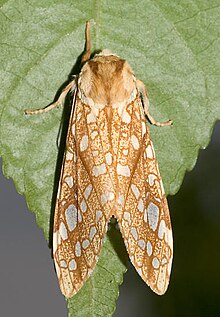Lophocampa caryae: Difference between revisions
Bigwhitmer (talk | contribs) Added tribe Arctiini_(erebid_moths) |
Bigwhitmer (talk | contribs) Cleanup wikilink |
||
| Line 7: | Line 7: | ||
}}{{italic title}} |
}}{{italic title}} |
||
'''''Lophocampa caryae''''', the '''hickory tiger moth''', '''hickory tussock moth''' or '''hickory halisidota''', is a moth in the family [[Erebidae]] and the tribe [[Arctiini_(erebid_moths)]], the tiger moths. The species is widely distributed in the eastern half of [[North America]].<ref>http://mothphotographersgroup.msstate.edu/species.php?hodges=8211{{full citation needed|date=September 2016}}</ref> Like most species in its family, the [[caterpillar]]s acquire chemical defenses from their host plants, so they are potentially toxic or unpalatable,<ref name=well>{{cite journal |last1=Weller |first1=Susan J. |last2=Jacobson |first2=Nancy L. |last3=Conner |first3=William E. |title=The evolution of chemical defences and mating systems in tiger moths (Lepidoptera: Arctiidae) |journal=Biological Journal of the Linnean Society |volume=68 |issue=4 |year=1999 |pages=557–78 |doi=10.1111/j.1095-8312.1999.tb01188.x }}</ref> but this species is also venomous.<ref>{{cite journal |last1=Kuspis |first1=Denise A. |last2=Rawlins |first2=J.E. |last3=Krenzelok |first3=Edward P. |title=Human exposures to stinging caterpillar: Lophocampa caryae exposures |journal=The American Journal of Emergency Medicine |volume=19 |issue=5 |pages=396–8 |year=2001 |pmid=11555796 |doi=10.1053/ajem.2001.25772 }}</ref> The behaviour and [[aposematism|aposematic]] coloration of the larvae suggests chemical protection in this stage, although they have not been analyzed for alkaloid or [[cardenolide]] content, nor have the adults.{{citation needed|date=September 2016}} |
'''''Lophocampa caryae''''', the '''hickory tiger moth''', '''hickory tussock moth''' or '''hickory halisidota''', is a moth in the family [[Erebidae]] and the tribe [[Arctiini_(erebid_moths)|Arctiini]], the tiger moths. The species is widely distributed in the eastern half of [[North America]].<ref>http://mothphotographersgroup.msstate.edu/species.php?hodges=8211{{full citation needed|date=September 2016}}</ref> Like most species in its family, the [[caterpillar]]s acquire chemical defenses from their host plants, so they are potentially toxic or unpalatable,<ref name=well>{{cite journal |last1=Weller |first1=Susan J. |last2=Jacobson |first2=Nancy L. |last3=Conner |first3=William E. |title=The evolution of chemical defences and mating systems in tiger moths (Lepidoptera: Arctiidae) |journal=Biological Journal of the Linnean Society |volume=68 |issue=4 |year=1999 |pages=557–78 |doi=10.1111/j.1095-8312.1999.tb01188.x }}</ref> but this species is also venomous.<ref>{{cite journal |last1=Kuspis |first1=Denise A. |last2=Rawlins |first2=J.E. |last3=Krenzelok |first3=Edward P. |title=Human exposures to stinging caterpillar: Lophocampa caryae exposures |journal=The American Journal of Emergency Medicine |volume=19 |issue=5 |pages=396–8 |year=2001 |pmid=11555796 |doi=10.1053/ajem.2001.25772 }}</ref> The behaviour and [[aposematism|aposematic]] coloration of the larvae suggests chemical protection in this stage, although they have not been analyzed for alkaloid or [[cardenolide]] content, nor have the adults.{{citation needed|date=September 2016}} |
||
==Life cycle== |
==Life cycle== |
||
Revision as of 15:47, 16 September 2019
| Lophocampa caryae | |
|---|---|

| |
| Scientific classification | |
| Domain: | Eukaryota |
| Kingdom: | Animalia |
| Phylum: | Arthropoda |
| Class: | Insecta |
| Order: | Lepidoptera |
| Superfamily: | Noctuoidea |
| Family: | Erebidae |
| Subfamily: | Arctiinae |
| Genus: | Lophocampa |
| Species: | L. caryae
|
| Binomial name | |
| Lophocampa caryae Harris, 1841
| |
| Synonyms | |
|
Halysidota caryae | |
Lophocampa caryae, the hickory tiger moth, hickory tussock moth or hickory halisidota, is a moth in the family Erebidae and the tribe Arctiini, the tiger moths. The species is widely distributed in the eastern half of North America.[1] Like most species in its family, the caterpillars acquire chemical defenses from their host plants, so they are potentially toxic or unpalatable,[2] but this species is also venomous.[3] The behaviour and aposematic coloration of the larvae suggests chemical protection in this stage, although they have not been analyzed for alkaloid or cardenolide content, nor have the adults.[citation needed]
Life cycle
There is one generation per year.[4]

Larva
The larva, a caterpillar, is completely covered in long, hairlike setae arranged in spreading tufts. Most are white, but there are black tufts along the middle of the back, and four long black hair pencils, two near the front, and two near the back. These hairs cause itchy rashes (contact dermatitis) in many people, particularly those prone to allergies, and may resemble exposure to urushiol.[4] They are microscopically barbed and may cause serious medical complications if they are transferred from the hands to the eyes.[5] There are black spots along the sides, and the head capsule is black.
The later-instar caterpillars are seen between July to October.[4] They feed in groups of about 100 or so in the early instars,[4] skeletonizing leaves. Older larvae are solitary. They grow up to 4.5 centimeters long before pupating.
Pupa
The cocoon is loose and has setae woven into it. It overwinters in the leaf litter.[4]
Adult
The adult moth flies in May and June. The forewings are yellowish-brown marked with white splotches, reminiscent of stained glass. The hindwings are mostly white. The body is hairy and pale brown.[6]
The moth primarily feeds on hickory, pecan and walnuts, but will also eat ash, elm, oak, willow, and other plants.[4] It occasionally causes local defoliation of nut trees, but high densities do not last long enough to cause significant damage.[6]
References
- ^ http://mothphotographersgroup.msstate.edu/species.php?hodges=8211[full citation needed]
- ^ Weller, Susan J.; Jacobson, Nancy L.; Conner, William E. (1999). "The evolution of chemical defences and mating systems in tiger moths (Lepidoptera: Arctiidae)". Biological Journal of the Linnean Society. 68 (4): 557–78. doi:10.1111/j.1095-8312.1999.tb01188.x.
- ^ Kuspis, Denise A.; Rawlins, J.E.; Krenzelok, Edward P. (2001). "Human exposures to stinging caterpillar: Lophocampa caryae exposures". The American Journal of Emergency Medicine. 19 (5): 396–8. doi:10.1053/ajem.2001.25772. PMID 11555796.
- ^ a b c d e f Wagner, D. L. Caterpillars of Eastern North America. Princeton University Press. 2005.[page needed]
- ^ Common Caterpillars are Dangerous to Touch! Carnegie Museum of Natural History.
- ^ a b Rose, A. H. and O. H. Lindquist. (1982). Insects of Eastern Hardwood Trees. Canadian Forestry service, Forestry Tech Rep 29. Government of Canada, Ottawa. ISBN 0-660-11205-1.[page needed]
Further reading
- Hossler, Eric W. (2010). "Caterpillars and moths: Part II. Dermatologic manifestations of encounters with Lepidoptera". Journal of the American Academy of Dermatology. 62 (1): 13–28, quiz 29–30. doi:10.1016/j.jaad.2009.08.061. PMID 20082887.

